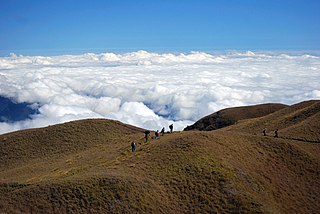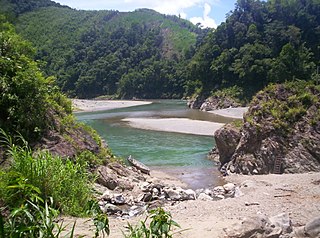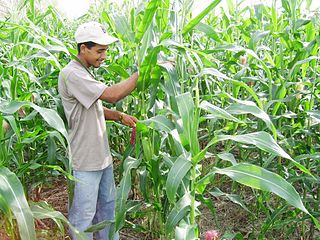| Type | Coffee |
|---|---|
| Country of origin | Cordillera |
| Region of origin | Northern Philippines |
| Introduced | Mid-19th century |
| Related products | Kona coffee and Jamaican Blue Mountain coffee |
Benguet coffee, also known as Benguet arabica, is a single-origin coffee varietal grown in the Cordillera highlands of the northern Philippines since the 19th century. It belongs to the species Coffea arabica , of the Typica variety. It is one of the main crops of farmers in the province of Benguet, which has a climate highly suitable for arabica cultivation. [1] Benguet coffee is listed in the Ark of Taste international catalogue of endangered heritage foods by the Slow Food movement. [2]
Arabica coffee is believed to have been introduced to the Cordillera highlands in the mid-19th century. According to William F. Pack, an American governor of Benguet (1909–1912) during the American colonial period, arabica coffee was first introduced to the Cordilleras in 1875 by a Spanish military governor of Benguet, Manuel Scheidnegal y Sera. He initially planted them in government gardens in the lowlands of the province to evaluate their potential as a regional crop. However, frequent rains and the low altitude were not ideal conditions for the plants. The next governor, Enrique Oraa, had greater success when he transplanted them at higher altitudes in 1877 and distributed seedlings among the native Igorot people. In 1881 however, the then governor, a certain Villena, attempted to coerce the natives into growing coffee by ordering them to do so. In protest, native communities destroyed arabica plantations at the advice of village elders. [3]
However, a native chief named Camising from Kabayan purportedly saw the benefits of the crop and introduced arabica coffee to his own people. His successes convinced neighboring communities to take up coffee cultivation on their own. Benguet coffee was part of the booming coffee industry of the Philippines during the 1880s and 1890s, which reached annual coffee exports of up to 16 million pounds. However, coffee rust devastated the plantations in 1899 and coffee production plummeted. By 1917, annual total export of coffee from the Philippines only amounted to around 3,000 pounds. [3] [4]
Pack praised Benguet coffee even then for its flavor and spearheaded a plan to rehabilite the industry while he was governor. [3] However, his efforts and that of the American colonial government failed. [4]
Benguet coffee cultivation is centered in the province of Benguet, mostly in backyard or small-scale farms. The coffee they produced were both for local consumption and sold as luxury exports to Spain, where they fetched high prices. [3] The coffee industry flourished in the mid-20th century as demand increased. But it faltered in the 1990s due to rapidly rising inflation and government neglect, resulting in farmers shifting to other crops like corn. [2] [5]
In recent years, provincial governments are attempting to bring back coffee production for both local and international markets. Production has steadily increased since 2010. In 2016, the Department of Trade and Industry in Cordillera launched a shared service facility and laboratory for processing and cupping arabica in the Benguet State University, the first in the country. Benguet is regarded as the top producer of quality arabica coffee in the Philippines and is in high demand. [6] [5] [7]
The Philippine coffee roadmap, which is the blue print of the country's coffee industry, aims to put the Philippines’ coffee sufficiency level at 161% by the year 2022. To be able to reach this goal, production volume has to increase by 145, 969.79 metric tons, production area has to expand by 99,879 hectares, and productivity will have to increase by 0.50 MT to make it 1 MT per hectare. In the Cordillera region coffee production is pegged to be at 3,735.86 MT of green beans coming from 6,322 hectares production area. [8]
Benguet coffee is characterized as having an acidity comparable to Hawaiian Kona coffee and Jamaican Blue Mountain coffee. [9] Benguet coffee is listed in the Ark of Taste international catalogue of endangered heritage foods by the Slow Food movement. [2] [10]

Cagayan Valley, designated as Region II, is an administrative region in the Philippines. Located in the northeastern section of Luzon, it is composed of five Philippine provinces: Batanes, Cagayan, Isabela, Nueva Vizcaya, and Quirino. The region hosts four chartered cities: Cauayan, Ilagan, Santiago, and Tuguegarao.

Benguet, officially the Province of Benguet, is a landlocked province of the Philippines located in the southern tip of the Cordillera Administrative Region in the island of Luzon. Its capital is La Trinidad.

Apayao, officially the Province of Apayao, is a landlocked province in the Philippines in the Cordillera Administrative Region in Luzon. Kabugao serves as its capital. The provincial capitol and its associated offices are located at the New Government Center in Luna.

The Rice Terraces of the Philippine Cordilleras are a World Heritage Site consisting of a complex of rice terraces on the island of Luzon in the Philippines. They were inscribed on the UNESCO World Heritage List in 1995, the first-ever property to be included in the cultural landscape category of the World Heritage List. This inscription has five sites: the Batad Rice Terraces and Bangaan Rice Terraces, Mayoyao Rice Terraces, Hungduan Rice Terraces and Nagacadan Rice Terraces, all in Ifugao Province. The Ifugao Rice Terraces reach a higher altitude and were built on steeper slopes than many other terraces. The Ifugao complex of stone or mud walls and the careful carving of the natural contours of hills and mountains to make terraced pond fields, coupled with the development of intricate irrigation systems, harvesting water from the forests of the mountain tops, and an elaborate farming system.

Kapeng barako, also known as Barako coffee or Batangas coffee, is a coffee varietal grown in the Philippines, particularly in the provinces of Batangas and Cavite. It belongs to the species Coffea liberica. The term is also used to refer to all coffee coming from those provinces. Barako in the languages of the Philippines means "stud", and is associated with the image of masculinity. Barako has a strong flavor and fragrance reminiscent of aniseed.

Agriculture in the Philippines is an important sector in the economy with crops like bananas, coconuts, pineapples, rice and sugarcanes are being mass-produced for exportation but the challenge remains as it steadily running into deficit amid growing population. As of 2022, the sector employs 24% of the Filipino workforce and it accounted for 8.9% of the total GDP.

The southeast Asian country of Laos, with a landmass of 23.68 million hectares, has at least 5 million hectares of land suitable for cultivation. Seventeen percent of this land area is actually cultivated, less than 4 percent of the total area.

Indonesia was the fourth-largest producer of coffee in the world in 2014. Coffee cultivation in Indonesia began in the late 1600s and early 1700s, in the early Dutch colonial period, and has played an important part in the growth of the country. Indonesia is geographically and climatologically well-suited for coffee plantations, near the equator and with numerous interior mountainous regions on its main islands, creating well-suited microclimates for the growth and production of coffee.

Coffee production in India is dominated in the hill tracts of South Indian states, with Karnataka accounting for 71%, followed by Kerala with 21% and Tamil Nadu. Indian coffee is said to be the finest coffee grown in the shade rather than direct sunlight anywhere in the world. There are about 250,000 coffee growers in the country; 98% of them are small growers. As of 2009, Indian coffee made up just 4.5% of the global production. Almost 80% of Indian coffee is exported; 70% is bound for Germany, Russia, Spain, Belgium, Slovenia, United States, United Kingdom, Japan, Greece, Netherlands and France. Italy accounts for 29% of the exports. Most of the export is shipped through the Suez Canal.

Coffee was said to have been introduced in the Philippines around 1696 when the Dutch introduced coffee in the islands. It was once a major industry in the Philippines, which by the 1800s was the fourth largest coffee producing nation.

Rice production in the Philippines is an important aspect of the country's food supply and economy. The Philippines is the 8th largest rice producer in the world, accounting for 2.8% of global rice production. The Philippines was also the world's largest rice importer in 2010. There is an estimated 2.4 million rice farmers in the Philippines as of 2020.

Agriculture in Panama is an important sector of the Panamanian economy. Major agricultural products include bananas, cocoa beans, coffee, coconuts, timber, beef, chicken, shrimp, corn, potatoes, rice, soybeans, and sugar cane.

The coffee production in Mexico is the world's 8th largest with 252,000 tonnes produced in 2009, and is mainly concentrated to the south central to southern regions of the country. The coffee is mainly arabica, which grows particularly well in the coastal region of Soconusco, Chiapas, near the border of Guatemala.

Coffee production in Tanzania is a significant aspect of its economy as it is Tanzania's largest export crop. Tanzanian coffee production averages between 30,000 and 40,000 metric tons annually of which approximately 70% is Arabica and 30% is Robusta.

Coffee is Uganda's top-earning export crop. In 1989 Uganda's coffee production capacity exceeded its quota of 2.3 million bags, but export volumes were still diminished by economic and security problems, and large amounts of coffee beans were still being smuggled out of Uganda for sale in neighbouring countries. Uganda is one of the few countries in the world with indigenous coffee, with Robusta coffee growing wild around Lake Victoria.

Coffee production in Sri Lanka peaked in 1870, with over 111,400 hectares being cultivated. The Dutch had experimented with coffee cultivation in the 18th century, but it was not successful until the British began large scale commercial production following the Colebrooke–Cameron Commission reforms of 1833. By 1860, the country was amongst the major coffee-producing nations in the world. Although coffee production remains a source of revenue, it is no longer a main economic sector. In 2014, the country ranked 43rd of largest coffee producers in the world.
The chocolate industry in the Philippines developed after introducing the cocoa tree into Philippine agriculture. The growing of cacao or cocoa boasts a long history stretching from the colonial times. Originating from Mesoamerican forests, cacao was first introduced by the Spanish colonizers four centuries ago. Since then the Philippine cocoa industry has been the primary producer of cocoa beans in Southeast Asia. There are many areas of production of cacao in the Philippines, owing to soil and climate. The chocolate industry is currently on a small to medium scale.

Sagada coffee, also known as Sagada arabica, is a single-origin coffee varietal grown in Sagada in the Cordillera highlands of the northern Philippines. It belongs to the species Coffea arabica, of the Typica variety.
Kahawa Sūg, also known as Sulu coffee or Sulu robusta, is a single-origin coffee varietal grown by the Tausug people of the Sulu Archipelago, Philippines. It is a robusta cultivar, belonging to the species Coffea canephora. It originates from robusta plants introduced to Sulu in the 1860s. It is an important part of traditional Tausug culture. It is mostly consumed locally, though it has started being exported more widely in recent years. It is currently endangered by the introduction of modern higher yield coffee varieties.